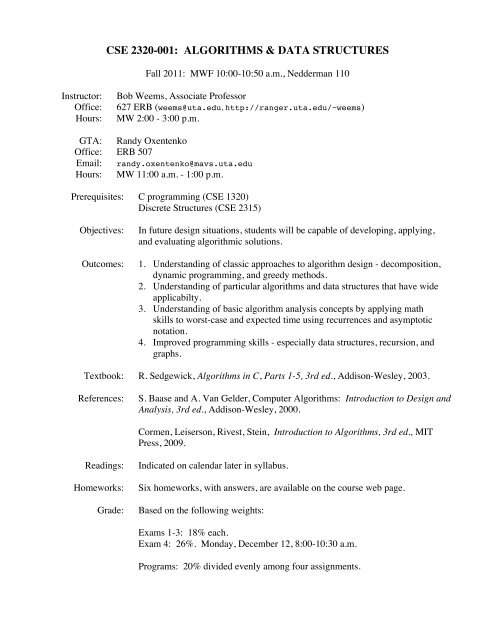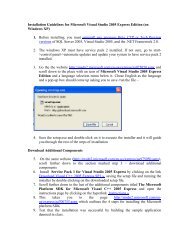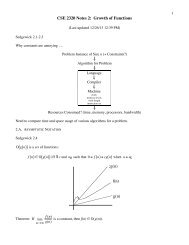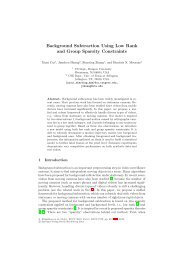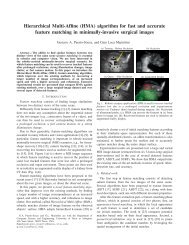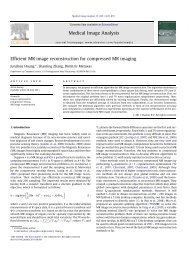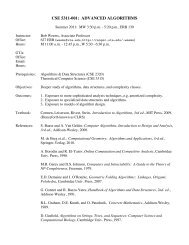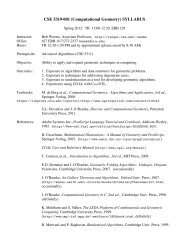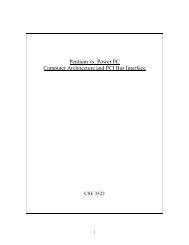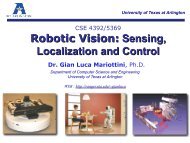cse 2320-001: algorithms & data structures - The University of Texas ...
cse 2320-001: algorithms & data structures - The University of Texas ...
cse 2320-001: algorithms & data structures - The University of Texas ...
Create successful ePaper yourself
Turn your PDF publications into a flip-book with our unique Google optimized e-Paper software.
CSE <strong>2320</strong>-<strong>001</strong>: ALGORITHMS & DATA STRUCTURES<br />
Fall 2011: MWF 10:00-10:50 a.m., Nedderman 110<br />
Instructor:<br />
Office:<br />
Hours:<br />
Bob Weems, Associate Pr<strong>of</strong>essor<br />
627 ERB (weems@uta.edu, http://ranger.uta.edu/~weems)<br />
MW 2:00 - 3:00 p.m.<br />
GTA: Randy Oxentenko<br />
Office: ERB 507<br />
Email:<br />
Hours: MW 11:00 a.m. - 1:00 p.m.<br />
randy.oxentenko@mavs.uta.edu<br />
Prerequisites: C programming (CSE 1320)<br />
Discrete Structures (CSE 2315)<br />
Objectives:<br />
Outcomes:<br />
In future design situations, students will be capable <strong>of</strong> developing, applying,<br />
and evaluating algorithmic solutions.<br />
1. Understanding <strong>of</strong> classic approaches to algorithm design - decomposition,<br />
dynamic programming, and greedy methods.<br />
2. Understanding <strong>of</strong> particular <strong>algorithms</strong> and <strong>data</strong> <strong>structures</strong> that have wide<br />
applicabilty.<br />
3. Understanding <strong>of</strong> basic algorithm analysis concepts by applying math<br />
skills to worst-case and expected time using recurrences and asymptotic<br />
notation.<br />
4. Improved programming skills - especially <strong>data</strong> <strong>structures</strong>, recursion, and<br />
graphs.<br />
Textbook: R. Sedgewick, Algorithms in C, Parts 1-5, 3rd ed., Addison-Wesley, 2003.<br />
References:<br />
S. Baase and A. Van Gelder, Computer Algorithms: Introduction to Design and<br />
Analysis, 3rd ed., Addison-Wesley, 2000.<br />
Cormen, Leiserson, Rivest, Stein, Introduction to Algorithms, 3rd ed., MIT<br />
Press, 2009.<br />
Readings:<br />
Homeworks:<br />
Grade:<br />
Indicated on calendar later in syllabus.<br />
Six homeworks, with answers, are available on the course web page.<br />
Based on the following weights:<br />
Exams 1-3: 18% each.<br />
Exam 4: 26%. Monday, December 12, 8:00-10:30 a.m.<br />
Programs: 20% divided evenly among four assignments.
Policies:<br />
1. Regular attendance is expected. You are expected to know lecture contents and announcements. I<br />
reserve the right to have surprise quizzes, each quiz being 2% <strong>of</strong> the semester grade taken from the<br />
80% allocated to exams.<br />
2. Lecture notes and sample code for various <strong>algorithms</strong> are on the course web page<br />
http://ranger.uta.edu/~weems/NOTES<strong>2320</strong>/<strong>cse</strong><strong>2320</strong>.html.<br />
3. You are expected to have read the assigned readings by the specified date. Lectures will review and<br />
augment the material, but will also consider exercises from the book.<br />
4. CHEATING - YOU ARE EXPECTED TO KNOW UNIVERSITY POLICIES. If you are suspected<br />
<strong>of</strong> cheating, the matter must go through university channels outside <strong>of</strong> the CSE Department.<br />
a. Academic Integrity Policy: It is the policy <strong>of</strong> the <strong>University</strong> <strong>of</strong> <strong>Texas</strong> at Arlington to uphold<br />
and support standards <strong>of</strong> personal honesty and integrity for all students consistent with the goals<br />
<strong>of</strong> a community <strong>of</strong> scholars and students seeking knowledge and truth. Furthermore, it is the<br />
policy <strong>of</strong> the <strong>University</strong> to enforce these standards through fair and objective procedures<br />
governing instances <strong>of</strong> alleged dishonesty, cheating, and other academic/non-academic<br />
misconduct.<br />
You can assume responsibility in two ways. First, if you choose to take the risk associated with<br />
scholastic dishonesty and any other violation <strong>of</strong> the Code <strong>of</strong> Student Conduct and Discipline, you<br />
must assume responsibility for your behaviors and accept the consequences. In an academic<br />
community, the standards for integrity are high. Second, if you are aware <strong>of</strong> scholastic<br />
dishonesty and any other conduct violations on the part <strong>of</strong> others, you have the responsibility to<br />
report it to the pr<strong>of</strong>essor or assistant dean <strong>of</strong> students/director <strong>of</strong> student judicial affairs. <strong>The</strong><br />
decision to do so is another moral dilemna to be faced as you define who you are. Students who<br />
violate <strong>University</strong> rules on scholastic dishonesty are subject to disciplinary penalties, including<br />
the possibility <strong>of</strong> failure in the course and dismissal from the <strong>University</strong>. Since dishonesty harms<br />
the individual, all students, and the integrity <strong>of</strong> the <strong>University</strong>, policies on scholastic dishonesty<br />
will be strictly enforced.<br />
b. Statement on Ethics, Pr<strong>of</strong>essionalism, and Conduct <strong>of</strong> Engineering Students: <strong>The</strong> statement<br />
is attached. Failure to sign the statement will result in 1) programming assignments to not be<br />
accepted, i.e. late penalty and 2) failure on exams.<br />
5. Any request for special consideration must be appropriately documented in advance. (Special<br />
consideration does not include giving a higher grade than has been earned.)<br />
6. Late programs are penalized according to the following schedule. LABS ARE DUE AT 9:45 AM<br />
ON THE DUE DATE, NOT MIDNIGHT. After the due time, assistance will not be provided.<br />
Degree <strong>of</strong> lateness<br />
Up to 9:45 next day<br />
Up to 9:45 two days<br />
Up to 9:45 three days<br />
Penalty<br />
10 pts<br />
30 pts<br />
60 pts
7. Each student will have available one 2-day, no-penalty extension that may be applied to one <strong>of</strong> the<br />
lab assignments. To use your extension you must send an email to a grader before the due time. An<br />
acknowledgement will be sent.<br />
RESUBMISSIONS BEFORE THE DUE TIME ARE PENALIZED 10 POINTS EACH. NO<br />
RESUBMISSIONS AFTER THE DUE TIME.<br />
8. Each lab is graded as follows:<br />
Some Issues<br />
a. Output/Code 60% If you know that your program has problems, you should<br />
let the GTA know what parts are functional. Test cases that<br />
demonstrate the limited functionality are useful.<br />
b. Internal Comments 6% Beginning <strong>of</strong> file including main() should identify the<br />
assignment and who you are, along with giving a high-level<br />
description.<br />
Each function: identify each argument, describe processing, and<br />
each return. You may reference notes and text.<br />
Excess line-by-line comments are not needed, but the processing<br />
for each iteration <strong>of</strong> a (significant) loop should be explained.<br />
c. Modularity 6% Functions are used appropriately. main() is kept simple.<br />
d. Structure 6% Code is not unnecessarily complicated or long. It is <strong>of</strong>ten better<br />
to rewrite code rather than patching several times.<br />
e. Names 6% Should indicate the purpose <strong>of</strong> the function, variable/field, or type.<br />
Cute or misleading names will be penalized.<br />
f. Spacing 6% Indenting, blank lines, placement <strong>of</strong> {}. Be consistent.<br />
g. Generality 10% Program is not unnecessarily limited.<br />
All programs must be written in C to compile and execute on omega.uta.edu. Details for program<br />
submission will be included with each assignment.<br />
You are responsible for correctly sending each programming assignment to the GTA as an<br />
attachment. (cc: yourself)<br />
No points will be awarded for programs that do not compile. Points for b-g will not be awarded to<br />
submissions that are not substantially complete and perform significant processing.<br />
9. GTA duties:<br />
a. Provide first-level <strong>of</strong> assistance for homeworks and labs.<br />
b. Grade programs and short-answer test problems.
10. Instructor duties:<br />
a. Lecture.<br />
b. Guidance<br />
c. Tests - preparation and grading long-answer test problems.<br />
d. Special consideration.<br />
e. Design homework and programming assignments.<br />
11. If you require a reasonable accomodation for a disability, please contact me no later than the<br />
second week <strong>of</strong> this semester. Further details are available at http://www.uta.edu/disability.<br />
12. Occasional class-wide email messages (e.g. weather situations, clarifications) may be sent to the<br />
addresses recorded by MyMav. Messages will also be archived on the course web page.<br />
Course Content (in chronological order)<br />
1. Algorithmic Concepts (1.1-1.3, 6.1-6.3, 5.2, 8.1-8.7, 2.6, 12.4) - Disjoint Subsets, Selection Sort,<br />
Insertion Sort, Divide and Conquer, Mergesort (trivial recursion tree), Binary Search (with and<br />
without duplicates)<br />
2. Growth <strong>of</strong> Functions (2.1-2.4, 2.6-2.7) - Asymptotic Notation (Ο, Ω, Θ), Upper Bounds, Lower<br />
Bounds<br />
3. Summations - Geometric Series, Harmonic Series, Math Induction, Integrals<br />
4. Recurrences (2.5) - Substitution Method, General Recursion Trees<br />
Exam 1: Notes 1.-4.<br />
5. Heapsort/Priority Queues (9.1-9.6) - Properties, Building a Heap, Sorting, Integrating with Other<br />
Data Structures<br />
6. Greedy Algorithms - Quality-<strong>of</strong>-Solution Issues, Unweighted Interval Scheduling, Knapsack,<br />
Huffman Codes<br />
7. Dynamic Programming (5.3) - Weighted Interval Scheduling, Optimal Matrix Multiplication,<br />
Longest Common Subsequence, Longest Increasing Subsequence, Subset Sum, Knapsack<br />
Exam 2: Notes 1.-7.<br />
8. Quicksort (7.1-7.8) - PARTITION (2 versions), Selection/Ranking<br />
Lower Bounds - Decision Tree Model, Stability (6.1)<br />
Counting (6.10) and Radix Sorts (10.1, 10.5)<br />
9. Linked Lists (3.3, 2.6, 12.3, 3.5, 3.4) - Use in Dictionaries, Headers, Sentinels, Circular Lists,<br />
Double Linking<br />
10. Stacks/Queues (4.2, 4.4, 18.1, 4.3, 4.6) - Policies and Applications<br />
11. Rooted Trees (5.4-5.7) - Structure, Traversals<br />
Binary Search Trees (12.5-12.9) - Properties, Operations<br />
Exam 3: Notes 8.-11.<br />
12. Balanced Binary Search Trees (13.3-13.4) - Structural Properties, Rotations, Insertions<br />
13. Hashing (14.1-14.4) - Concepts, Chaining, Open Addressing<br />
14. Graph Representations (3.7, 17.3-17.4) - Adjacency Matrices, Adjacency Lists, Compressed<br />
Adjacency Lists<br />
Search - Breadth-First (5.8, 18.7), Depth-First (19.2, 5.8, 18.2-18.4)<br />
Search-Based Algorithms - Topological Sort (19.6), Strong Components (19.8)
15. Minimum Spanning Trees (20.1-20.4) - Three Versions <strong>of</strong> Prim’s MST, Kruskal’s MST<br />
16. Shortest Paths - Dijkstra’s Algorithm (21.1-21.2), Warshall’s Algorithm (19.3), Floyd-Warshall<br />
Algorithm (21.3)<br />
17. Network Flows and Bipartite Matching (22.1, 22.2, 22.4) - Concepts, Augmenting Paths, Residual<br />
Network, Cuts, Max-flow Min-cut <strong>The</strong>orem, Implementation, Performance Issues<br />
Exam 4: Items 12.-17.<br />
Calendar - with subject numbers from course content<br />
August/September<br />
October<br />
26 Syllabus 3 No Class 5 7. 7 7.<br />
29 1. 31 1. 2 2. 10 7. 12 8. 14 8.<br />
5 Holiday 7 No Class 9 2. 17 Exam 2 19 9. 21 9.<br />
12 2./3. 14 4. 16 4. 24 10. 26 10. 28 11.<br />
19 5. 21 5. 23 6. 31 11.<br />
26 Exam 1 28 6. 30 7.<br />
November<br />
December<br />
2 12. 4 12. 2 16.<br />
7 Exam 3 9 12. 11 13. 5 16. 7 17. 9 17.<br />
14 13. 16 14. 18 14. 12 Exam 4<br />
21 14. 23 14. 25 Holiday<br />
28 15. 30 15.<br />
November 4 is the last day to drop.
Statement <strong>of</strong> Ethics<br />
Student Confirmation<br />
(CSE <strong>2320</strong>, Fall 2011)<br />
<strong>The</strong> following is an excerpt from the College <strong>of</strong> Engineering’s statement on Ethics, Pr<strong>of</strong>essionalism, and Conduct <strong>of</strong><br />
Engineering Students. <strong>The</strong> notes are modifications appropriate for Computer Science and Engineering courses. Read the<br />
statement carefully, sign it, and return it to your instructor. Additional copies <strong>of</strong> this statement can be obtained from your<br />
instructor or the Computer Science and Engineering <strong>of</strong>fice.<br />
Statement on Ethics, Pr<strong>of</strong>essionalism, and Conduct <strong>of</strong> Engineering Students<br />
College <strong>of</strong> Engineering<br />
<strong>The</strong> <strong>University</strong> <strong>of</strong> <strong>Texas</strong> at Arlington<br />
<strong>The</strong> College cannot and will not tolerate any form <strong>of</strong> academic dishonesty by its students. This includes, but is not limited to<br />
1) cheating on examination, 2) plagiarism, or 3) collusion.<br />
Definitions:<br />
A. Cheating on an examination includes:<br />
1. Copying from another’s paper, any means <strong>of</strong> communication with another during an examination, giving aid to<br />
or receiving aid from another during an examination;<br />
2. Using any material during an examination that is unauthorized by the proctor;<br />
3. Taking or attempting to take an examination for another student or allowing another student to take or attempt<br />
to take an examination for oneself.<br />
4. Using, obtaining, or attempting to obtain by any means the whole or any part <strong>of</strong> an unadministered examination.<br />
B. Plagiarism is the unacknowledged incorporation <strong>of</strong> another’s work into work which the student <strong>of</strong>fers for credit.<br />
C. Collusion is the unauthorized collaboration <strong>of</strong> another in preparing work that a student <strong>of</strong>fers for credit.<br />
D. Other types <strong>of</strong> academic dishonesty include using other student’s printouts from the ACS labs or students’ disk, etc.<br />
1. <strong>The</strong> use <strong>of</strong> the source code <strong>of</strong> another person’s program, even temporarily, is considered plagiarism.<br />
2. Allowing another person to use your source code, even temporarily, is considered collusion.<br />
3. Use <strong>of</strong> another person’s source code with your modification is considered plagiarism.<br />
4. Taking material verbatim (without quoting the source) for reports and/or presentations is considered plagiarism<br />
5. For this class, the specific exceptions given below are not considered scholastically dishonest acts:<br />
Discussion <strong>of</strong> the algorithm and general programming techniques used to solve a problem<br />
<strong>The</strong> penalty assessed for cheating on a given assignment will be twice the weight <strong>of</strong> the assignment and will include<br />
notification <strong>of</strong> the proper authorities as stipulated in the UTA Handbook <strong>of</strong> Operating Procedures and on the web at<br />
http://www.uta.edu/studentaffairs/conduct/homedisci.html<br />
You may be entitled to know what information UT Arlington (UTA) collects concerning you. You may review and have<br />
UTA correct this information according to procedures set forth in UT System BPM #32. <strong>The</strong> law is found in sections<br />
552.021, 552.023 and 559.004 <strong>of</strong> the <strong>Texas</strong> Government Code.<br />
I have read and I understand the above statement.<br />
Student’s signature:<br />
Student’s name (printed):<br />
Student’s ID number:<br />
_________________________________________________<br />
_________________________________________________<br />
_________________________________________________


